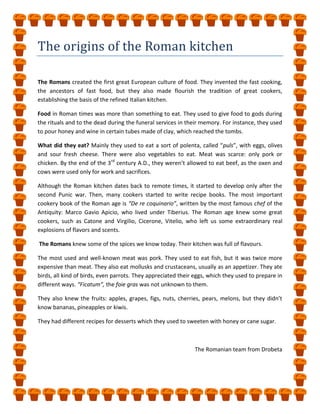
The origins of the roman kitchen
- 1. The origins of the Roman kitchen The Romans created the first great European culture of food. They invented the fast cooking, the ancestors of fast food, but they also made flourish the tradition of great cookers, establishing the basis of the refined Italian kitchen. Food in Roman times was more than something to eat. They used to give food to gods during the rituals and to the dead during the funeral services in their memory. For instance, they used to pour honey and wine in certain tubes made of clay, which reached the tombs. What did they eat? Mainly they used to eat a sort of polenta, called “puls”, with eggs, olives and sour fresh cheese. There were also vegetables to eat. Meat was scarce: only pork or chicken. By the end of the 3rd century A.D., they weren’t allowed to eat beef, as the oxen and cows were used only for work and sacrifices. Although the Roman kitchen dates back to remote times, it started to develop only after the second Punic war. Then, many cookers started to write recipe books. The most important cookery book of the Roman age is “De re coquinario”, written by the most famous chef of the Antiquity: Marco Gavio Apicio, who lived under Tiberius. The Roman age knew some great cookers, such as Catone and Virgilio, Cicerone, Vitelio, who left us some extraordinary real explosions of flavors and scents. The Romans knew some of the spices we know today. Their kitchen was full of flavours. The most used and well-known meat was pork. They used to eat fish, but it was twice more expensive than meat. They also eat mollusks and crustaceans, usually as an appetizer. They ate birds, all kind of birds, even parrots. They appreciated their eggs, which they used to prepare in different ways. “Ficatum”, the foie gras was not unknown to them. They also knew the fruits: apples, grapes, figs, nuts, cherries, pears, melons, but they didn’t know bananas, pineapples or kiwis. They had different recipes for desserts which they used to sweeten with honey or cane sugar. The Romanian team from Drobeta